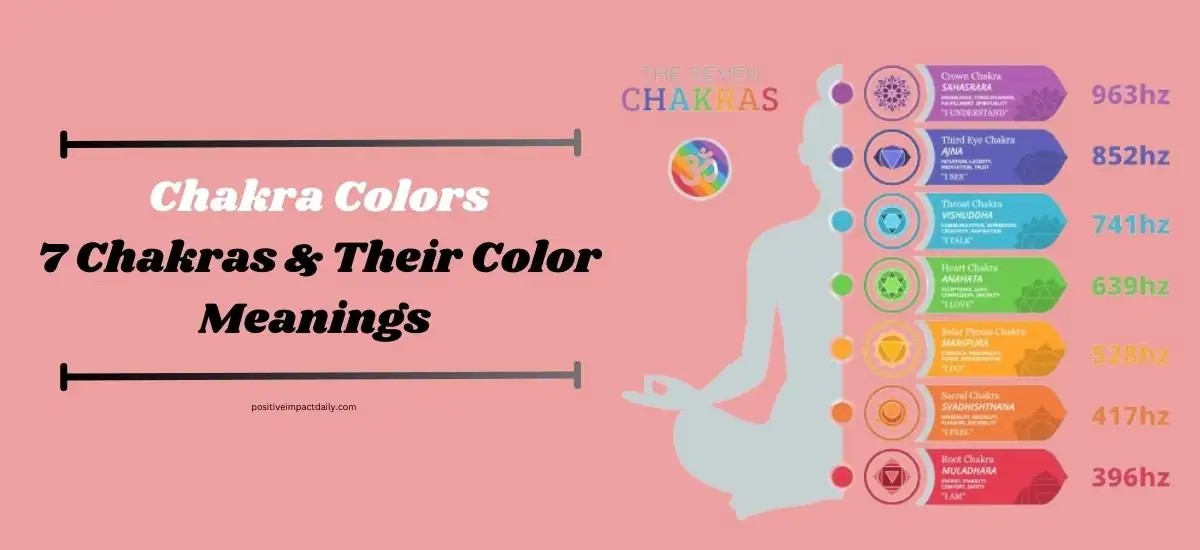Chakras are often described as “wheels of light,” a term originating from the Sanskrit language. These colorful vortexes of energy spin at different speeds, creating the aura, a luminous energy field that surrounds the body:
- Energy Vortexes: Chakras function as energy centers, each with its unique color, spinning speed, and wavelength, contributing to overall energy flow.
- Aura Creation: The spinning of chakras creates the aura, a visual manifestation of these energy flows around the body.
Understanding the relationship between chakras and their colors provides insight into their functions and how they contribute to spiritual and physical well-being:
- Color Association: Each chakra is associated with a specific color, influencing its energy flow and functionality.
- Balancing Energy: Balanced chakras contribute to healthy energy flow, supporting holistic wellness.
This article delves into the meanings of each chakra’s color, its influence on energy flow, and its role in fostering holistic wellness:
- Color Meanings: Explore the symbolic meanings of each color and its role in governing energy flow.
- Spiritual Growth: Understand how balanced chakras contribute to spiritual growth and holistic wellness.
- Holistic Wellness: Learn techniques to balance chakras and promote overall health.
Understanding Chakra Colors
Chakras are energy centers that govern emotional, physical, and spiritual well-being. Each chakra is associated with a specific color, reflecting its unique energy flow and influence on holistic wellness:
- Color Correlation: The color associated with each chakra reflects its energy flow, functionality, and influence:
- Root Chakra: Red, representing grounding, stability, and security.
- Sacral Chakra: Orange, symbolizing creativity, sexuality, and emotional expression.
- Solar Plexus Chakra: Yellow, reflecting personal power, self-confidence, and transformation.
- Heart Chakra: Green, signifying love, compassion, and connection.
- Throat Chakra: Light Blue/Turquoise, indicating communication, self-expression, and authenticity.
- Third Eye Chakra: Indigo or Dark Blue, symbolizing intuition, insight, and mental clarity.
- Crown Chakra: Violet or White, representing spiritual connection and enlightenment.
- Energy Flow: Balanced chakras contribute to healthy energy flow, supporting holistic wellness:
- Spinning Speed: Chakra spinning speed influences energy flow and balance.
- Light Wavelength: Color wavelength reflects the chakra’s energy flow and functionality.
- Impact on Aura: Chakra colors contribute to the aura’s appearance, extending the energy field around the body:
- Balanced Aura: Balanced chakras contribute to a balanced aura, supporting holistic wellness.
- Energy Flow: Chakra energy flow influences the aura’s vibrancy and health.
By understanding chakra colors and their meanings, individuals can promote balanced energy flow and holistic wellness:
- Holistic Wellness: Balanced chakras integrate emotional, spiritual, and physical health.
- Spiritual Growth: Chakra balance fosters spiritual growth, supporting holistic wellness.
- Energy Flow: Balanced energy flow supports holistic health, nurturing overall well-being.
The 7 Chakras and Their Colors
The chakra system consists of seven main energy centers, each associated with a specific color and representing different aspects of holistic wellness:
- Root Chakra (Muladhara):
- Color: Red
- Location: Base of the spine
- Attributes: Grounding, stability, and physical security.
- Role: Governs survival instincts, providing foundational support for emotional, physical, and spiritual well-being.
- Sacral Chakra (Svadhisthana):
- Color: Orange
- Location: A couple of inches below the navel.
- Attributes: Creativity, sexuality, and emotional expression.
- Role: Governs creative and emotional energies, nurturing balanced relationships and holistic wellness.
- Solar Plexus Chakra (Manipura):
- Color: Yellow
- Location: Upper abdomen, just below the ribcage.
- Attributes: Personal power, self-confidence, and transformation.
- Role: Governs self-esteem, decision-making, and inner strength, supporting personal growth.
- Heart Chakra (Anahata):
- Color: Green
- Location: Center of the chest.
- Attributes: Love, compassion, and connection.
- Role: Governs emotional balance, nurturing love, forgiveness, and connection, fostering healthy relationships.
- Throat Chakra (Vishuddha):
- Color: Light Blue/Turquoise
- Location: At the base of the throat.
- Attributes: Communication, self-expression, and authenticity.
- Role: Governs clear communication, honesty, and self-expression, fostering healthy relationships and interactions.
- Third Eye Chakra (Ajna):
- Color: Indigo or Dark Blue
- Location: Between the eyebrows.
- Attributes: Intuition, insight, and mental clarity.
- Role: Governs mental clarity, insight, and spiritual awareness, supporting balanced thinking and decision-making.
- Crown Chakra (Sahasrara):
- Color: Violet or White
- Location: At the top of the head.
- Attributes: Spiritual connection and enlightenment.
- Role: Governs spiritual connection, enlightenment, and higher consciousness, fostering holistic well-being.
By understanding the relationship between each chakra and its corresponding color, individuals can foster holistic wellness and balanced energy flow:
- Color Significance: Each chakra’s color reflects its role in supporting emotional, spiritual, and physical health.
- Balanced Energy: Balanced chakras contribute to healthy energy flow, supporting holistic wellness.
- Holistic Health: Chakra health contributes to balanced emotions, spiritual growth, and physical wellness.
Chakra Colors and Light Wavelengths
Chakras are energy centers that function as spinning wheels, each associated with a specific color, wavelength, and energy flow:
- Color Spectrum: The color spectrum ranges from red to violet, each corresponding to a different wavelength:
- Red: The longest wavelength, associated with the Root Chakra, represents grounding, stability, and vitality.
- Orange: Associated with the Sacral Chakra, symbolizes creativity, sexuality, and emotional balance.
- Yellow: Linked to the Solar Plexus Chakra, represents personal power, self-confidence, and transformation.
- Green: The color of the Heart Chakra, signifies love, compassion, and connection.
- Blue: Associated with the Throat Chakra, symbolizes communication, self-expression, and authenticity.
- Indigo: Corresponding to the Third Eye Chakra, represents intuition, insight, and mental clarity.
- Violet: The shortest wavelength, associated with the Crown Chakra, represents spiritual connection and enlightenment.
- Chakra Spinning Speed: The spinning speed of each chakra influences its wavelength and energy flow:
- Balanced Chakras: Spin at an even pace, promoting balanced energy flow.
- Imbalanced Chakras: May spin too fast or too slow, disrupting energy flow and overall well-being.
- Energy Flow: Chakra health impacts energy flow, influencing overall wellness:
- Balanced Energy: Contributes to healthy emotional, spiritual, and physical health.
- Aura Appearance: Balanced chakras contribute to a balanced aura, reflecting holistic wellness.
By understanding the relationship between chakra colors and their wavelengths, individuals can promote balanced energy flow and holistic wellness:
- Energy Balancing: Balanced chakras contribute to balanced energy flow, supporting holistic health.
- Holistic Health: Chakra health integrates emotional, spiritual, and physical well-being.
Benefits of Chakra Colors
Chakra colors not only symbolize specific aspects of holistic wellness but also offer practical benefits through their influence on energy and overall well-being:
- Attracting Energies: Chakra colors can attract specific energies into one’s life:
- Red: Attracts grounding, stability, and vitality, supporting the Root Chakra.
- Orange: Invites creativity, joy, and emotional balance, nurturing the Sacral Chakra.
- Yellow: Promotes personal power, confidence, and transformation, enhancing the Solar Plexus Chakra.
- Green: Encourages love, compassion, and connection, supporting the Heart Chakra.
- Blue: Facilitates clear communication, self-expression, and authenticity, enhancing the Throat Chakra.
- Indigo: Fosters intuition, insight, and mental clarity, supporting the Third Eye Chakra.
- Violet: Invites spiritual connection, enlightenment, and higher consciousness, nurturing the Crown Chakra.
- Techniques for Working with Colors: Chakra colors can be incorporated into daily life to balance energies and promote holistic wellness:
- Visualization: Visualize each chakra’s color during meditation, imagining its energy flowing freely.
- Diet: Incorporate foods of corresponding colors into one’s diet to nourish each chakra.
- Environment: Adjust home decor or wardrobe colors to promote balanced energies:
- Red: Adds grounding and stability to the home environment.
- Orange: Invites joy and creativity, fostering an uplifting atmosphere.
- Yellow: Brings clarity and confidence, promoting personal empowerment.
- Green: Cultivates love and harmony, nurturing balanced relationships.
- Blue: Encourages communication and self-expression, supporting authentic interactions.
- Indigo: Fosters intuition and insight, enhancing mental clarity.
- Violet: Invites spiritual connection, nurturing holistic well-being.
- Balanced Energies: Chakra colors contribute to balanced energies, promoting overall well-being:
- Holistic Health: Balanced chakras support emotional, spiritual, and physical well-being.
- Energy Flow: Balanced energies contribute to healthy energy flow, supporting chakra health.
By integrating chakra colors into daily life, individuals can promote balanced energies and holistic wellness:
- Color Therapy: Incorporating chakra colors promotes balanced energies, supporting holistic health.
- Energy Balancing: Balanced chakras contribute to balanced energy flow, nurturing holistic wellness.
Detailed Analysis of Each Chakra Color
Chakra colors represent various attributes and functions within the energy system:
- Root Chakra (Muladhara):
- Color: Red, representing grounding, stability, and survival.
- Benefits:
- Promotes physical security, vitality, and a sense of safety.
- Supports basic needs, including shelter, food, and emotional stability.
- Imbalances: Can manifest as fear, anxiety, or insecurity.
- Sacral Chakra (Svadhishthana):
- Color: Orange, symbolizing creativity, sexuality, and emotional expression.
- Benefits:
- Enhances creativity, joy, and pleasure, contributing to emotional balance.
- Supports healthy relationships, fostering intimacy and connection.
- Imbalances: Can lead to emotional instability, repressed creativity, or difficulty in relationships.
- Solar Plexus Chakra (Manipura):
- Color: Yellow, reflecting personal power, self-confidence, and transformation.
- Benefits:
- Boosts self-esteem, assertiveness, and decision-making.
- Fuels personal growth and transformation, contributing to confidence and intellectual clarity.
- Imbalances: Can result in low self-esteem, indecisiveness, or digestive issues.
- Heart Chakra (Anahata):
- Color: Green, signifying love, compassion, and connection.
- Benefits:
- Fosters love, forgiveness, and acceptance, promoting healthy relationships.
- Contributes to emotional balance, harmony, and overall well-being.
- Imbalances: Can lead to emotional instability, difficulty in relationships, or lack of self-love.
- Throat Chakra (Vishuddha):
- Color: Light Blue/Turquoise, indicating communication, self-expression, and authenticity.
- Benefits:
- Enhances communication, verbal expression, and honesty.
- Supports creativity and authentic interactions, fostering clarity.
- Imbalances: Can lead to difficulty expressing oneself, dishonesty, or communication issues.
- Third Eye Chakra (Ajna):
- Color: Indigo or Dark Blue, symbolizing intuition, insight, and mental clarity.
- Benefits:
- Enhances intuition, insight, and spiritual awareness.
- Supports mental clarity and inner wisdom, promoting balanced perspectives.
- Imbalances: Can lead to confusion, lack of insight, or difficulty in decision-making.
- Crown Chakra (Sahasrara):
- Color: Violet or White, representing spiritual connection and enlightenment.
- Benefits:
- Fosters spiritual connection, enlightenment, and higher consciousness.
- Supports holistic balance, nurturing overall well-being.
- Imbalances: Can lead to disconnection, confusion, or lack of spiritual direction.
Chakra colors reflect and influence various aspects of holistic wellness:
- Balance: Contribute to balanced energy flow, nurturing overall well-being.
- Healing: Chakra health supports emotional, spiritual, and physical well-being.
Practical Applications
Chakra colors offer practical ways to balance and heal energy systems:
- Chakra Stones:
- Red: Stones like Garnet or Ruby can balance the Root Chakra, grounding energy and promoting stability.
- Orange: Carnelian and Orange Calcite support the Sacral Chakra, enhancing creativity and emotional expression.
- Yellow: Citrine and Yellow Jasper balance the Solar Plexus Chakra, promoting self-confidence and clarity.
- Green: Green Aventurine and Jade support the Heart Chakra, fostering love, harmony, and emotional balance.
- Blue: Blue Lace Agate and Sodalite enhance the Throat Chakra, improving communication and self-expression.
- Indigo: Amethyst and Lapis Lazuli balance the Third Eye Chakra, supporting intuition and insight.
- Violet: Amethyst and Selenite nurture the Crown Chakra, fostering spiritual connection and enlightenment.
- Daily Integration:
- Clothing: Wearing clothes in chakra colors can balance energies, nurturing holistic wellness.
- Home Decor: Incorporating chakra colors into home decor supports balanced energy flow:
- Red: Adds grounding and stability.
- Orange: Invites joy and creativity.
- Yellow: Brings clarity and confidence.
- Green: Cultivates love and harmony.
- Blue: Encourages communication and self-expression.
- Indigo: Fosters intuition and insight.
- Violet: Invites spiritual connection.
- Diet: Consuming foods in chakra colors can support chakra health, enhancing overall well-being.
By integrating chakra colors into daily life, individuals can promote balanced energies and holistic wellness.
Conclusion
Chakra colors symbolize and influence various aspects of holistic wellness:
- Balance: Contribute to balanced energy flow, nurturing overall well-being.
- Healing: Chakra health supports emotional, spiritual, and physical well-being.
By understanding chakra colors and their meanings, individuals can integrate them into daily life, enhancing spiritual and physical wellness:
- Holistic Healing: Balanced chakras support emotional, spiritual, and physical health.
- Energy Flow: Balanced energies contribute to overall well-being.
Encourage readers to integrate chakra color knowledge into spiritual and wellness practices:
- Color Therapy: Incorporating chakra colors into daily life promotes balanced energies, supporting holistic health.
- Energy Balancing: Balanced chakras contribute to balanced energy flow, nurturing holistic wellness.
Read More –
Green Chakra: Heart Chakra (Anahata) Meaning & Symbolism
100+ Heart Chakra Affirmations for Manifesting Love & Forgiveness







